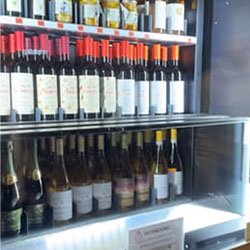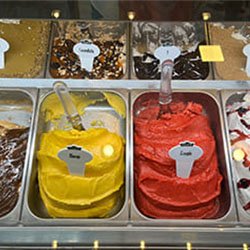
(The skies above Madeira Airport. I went to take a photo of the shadow of my plane on the ground and caught this rainbow.)
As I mentioned in my previous post, the Cristiano Ronaldo International Airport is the airport located in Funchal on the Madeira islands.
Landing at the airport is extremely dangerous, and it is always ranked among the world’s most treacherous. First, there are the geographical factors. There’s almost no flat land in Madeira, so they built the airport on a piece of land that juts out into the sea. On one side of the runway are mountains, with a steep drop-off on the other side as well as at either end of the strip. Below the cliffs is the ocean. Landing areas on plateaus or hills, where one or both sides drop off sharply into deep valleys are known as “tabletop runways,” and because the flat lands below them (or the ocean in this case) fool the instrumentation into thinking that everything is at the same height, pilots are required to perform a visual approach. The winds are strong as well, tilting the planes and making it extremely difficult to keep the aircraft balanced as it lands. It’s so difficult that pilots are required to undergo special training in order to land there.
But it used to be even more perilous.
When the airport opened in 1964, it had just two short runways measuring a mere 1,600 meters in length. Because it was surrounded by mountains and the sea, which made landing extremely difficult for even the most experienced pilots, people called it “the Kai Tak of Europe” (Kai Tak used to be an airport in Hong Kong).
The worst airline disaster recorded there was the crash of a TAP Air Portugal flight in 1977, which killed 131 of the 164 people on board. The runway was extended by 200 meters a few years later in 1986, in response to increasing tourism to the Madeira islands as well as to the crash, for a total length of 1,800 meters. In the year 2000, as tourist demand continued to rise, it was extended again to its current length of 2,781 meters.
Part of the runway extension isn’t on reclaimed land, but on a platform constructed over the water, supported by 180 pillars that are around 70 meters in height. The topography of the site made the construction project one of the most difficult in the world, and this innovative solution earned Funchal the Outstanding Structure Award in 2004 from the International Association for Bridge and Structural Engineering, which aims at recognizing remarkable, innovative, creative, or otherwise stimulating structures.

(Part of the runway at Madeira’s international airport is supported by multiple pillars, creating a platform over the ocean.)
The current runway at Madeira’s international airport is nearly twice as long as it was when the facility opened, and these days large aircraft can land there as well.
But when the weather is bad, flights still get canceled, or else end up circling around the airspace above and repeatedly trying to land while losing their balance and having to give up at the last minute.
https://www.youtube.com/watch?v=_JZkEBF8g3M&t=2s
(This YouTube video of a landing from March 2024 is harrowing, even if there were no passengers on the plane!)
This summer, Azores Airport started offering services that connect Funchal in Madeira with Toronto in Canada and Boston in the US.
Winston Churchill spent a lot of time in the Madeira islands, which may explain the strong British presence there and the reason Madeirans speak English with a heavy British accent. It seems to have become more Americanized recently, however, which might be the result of more direct flights to the US being offered.
EasyJet announced that it would start offering services from Amsterdam to Funchal in the Madeira Islands this winter.
It’s a little sad to see so many foreigners flooding Madeira, but they do need to create a less risky airport if the number of tourists is going to keep growing.






























































